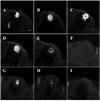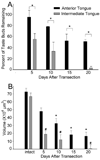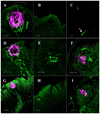Fungiform taste bud degeneration in C57BL/6J mice following chorda-lingual nerve transection
- PMID: 17626272
- PMCID: PMC2811721
- DOI: 10.1002/cne.21436
Fungiform taste bud degeneration in C57BL/6J mice following chorda-lingual nerve transection
Abstract
Taste buds are dependent on innervation for normal morphology and function. Fungiform taste bud degeneration after chorda tympani nerve injury has been well documented in rats, hamsters, and gerbils. The current study examines fungiform taste bud distribution and structure in adult C57BL/6J mice from both intact taste systems and after unilateral chorda-lingual nerve transection. Fungiform taste buds were visualized and measured with the aid of cytokeratin 8. In control mice, taste buds were smaller and more abundant on the anterior tip (<1 mm) of the tongue. By 5 days after nerve transection taste buds were smaller and fewer on the side of the tongue ipsilateral to the transection and continued to decrease in both size and number until 15 days posttransection. Degenerating fungiform taste buds were smaller due to a loss of taste bud cells rather than changes in taste bud morphology. While almost all taste buds disappeared in more posterior fungiform papillae by 15 days posttransection, the anterior tip of the tongue retained nearly half of its taste buds compared to intact mice. Surviving taste buds could not be explained by an apparent innervation from the remaining intact nerves. Contralateral effects of nerve transection were also observed; taste buds were larger due to an increase in the number of taste bud cells. These data are the first to characterize adult mouse fungiform taste buds and subsequent degeneration after unilateral nerve transection. They provide the basis for more mechanistic studies in which genetically engineered mice can be used.
(c) 2007 Wiley-Liss, Inc.
Figures








Similar articles
-
Hedgehog Signaling Regulates Taste Organs and Oral Sensation: Distinctive Roles in the Epithelium, Stroma, and Innervation.Int J Mol Sci. 2019 Mar 16;20(6):1341. doi: 10.3390/ijms20061341. Int J Mol Sci. 2019. PMID: 30884865 Free PMC article. Review.
-
Morphometric and immunocytochemical assessment of fungiform taste buds after interruption of the chorda-lingual nerve.Microsc Res Tech. 1993 Oct 15;26(3):187-95. doi: 10.1002/jemt.1070260302. Microsc Res Tech. 1993. PMID: 8241558
-
Time course of morphological alterations of fungiform papillae and taste buds following chorda tympani transection in neonatal rats.J Neurobiol. 2002 Jun 5;51(3):223-36. doi: 10.1002/neu.10055. J Neurobiol. 2002. PMID: 11984844 Free PMC article.
-
Chorda tympani nerve transection at different developmental ages produces differential effects on taste bud volume and papillae morphology in the rat.J Neurobiol. 2005 Sep 5;64(3):310-20. doi: 10.1002/neu.20140. J Neurobiol. 2005. PMID: 15898061 Free PMC article.
-
[Progress in the effects of injury and regeneration of gustatory nerves on the taste functions in animals].Sheng Li Xue Bao. 2014 Oct 25;66(5):519-27. Sheng Li Xue Bao. 2014. PMID: 25331997 Review. Chinese.
Cited by
-
Lingual Denervation Improves the Efficacy of Anti-PD-1 Immunotherapy in Oral Squamous Cell Carcinomas by Downregulating TGFβ Signaling.Cancer Res Commun. 2024 Feb 15;4(2):418-430. doi: 10.1158/2767-9764.CRC-23-0192. Cancer Res Commun. 2024. PMID: 38324026 Free PMC article.
-
Hedgehog Signaling Regulates Taste Organs and Oral Sensation: Distinctive Roles in the Epithelium, Stroma, and Innervation.Int J Mol Sci. 2019 Mar 16;20(6):1341. doi: 10.3390/ijms20061341. Int J Mol Sci. 2019. PMID: 30884865 Free PMC article. Review.
-
Astrocytic response to neural injury is larger during development than in adulthood and is not predicated upon the presence of microglia.Brain Behav Immun Health. 2019 Nov 25;1:100010. doi: 10.1016/j.bbih.2019.100010. eCollection 2020 Jan. Brain Behav Immun Health. 2019. PMID: 38377419 Free PMC article.
-
Taste bud regeneration and the search for taste progenitor cells.Arch Ital Biol. 2010 Jun;148(2):107-18. Arch Ital Biol. 2010. PMID: 20830973 Free PMC article. Review.
-
Reactive microglia after taste nerve injury: comparison to nerve injury models of chronic pain.F1000Res. 2013 Feb 28;2:65. doi: 10.12688/f1000research.2-65.v1. eCollection 2013. F1000Res. 2013. PMID: 24358861 Free PMC article.
References
-
- Agerman K, Hjerling-Leffler J, Blanchard MP, Scarfone E, Canlon B, Nosrat C, Ernfors P. BDNF gene replacement reveals multiple mechanisms for establishing neurotrophin specificity during sensory nervous system development. Development. 2003;130:1479–1491. - PubMed
-
- Cain P, Frank ME, Barry MA. Recovery of chorda tympani nerve function following injury. Exp Neurol. 1996;141:337–346. - PubMed
-
- Cavallin MA, McCluskey LP. Lipopolysaccharide-induced upregulation of activated macrophages in the degenerating taste system. J Neurosci Res. 2005;80:75–84. - PubMed
-
- Cheal M, Oakley B. Regeneration of fungiform taste buds: temporal and spatial characteristics. J Comp Neurol. 1977;172:609–626. - PubMed
Publication types
MeSH terms
Substances
Grants and funding
LinkOut - more resources
Full Text Sources
Research Materials

